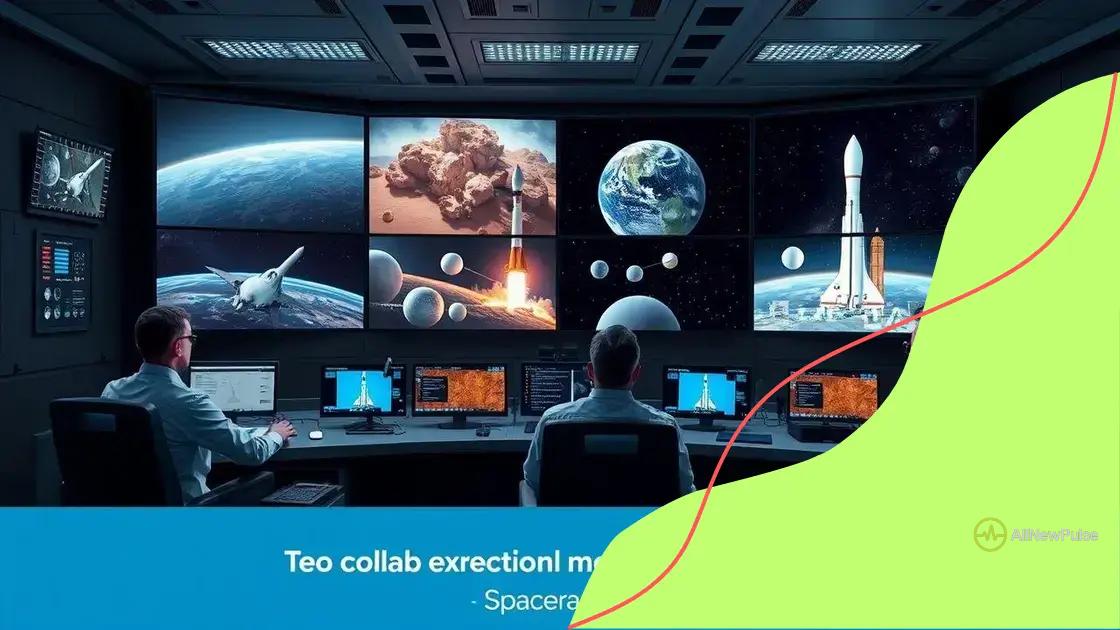Developments in space exploration and commercialization

Developments in space exploration and commercialization are transforming travel and habitation, with companies innovating in technology to make space accessible for tourism and sustainable living on the Moon and Mars.
Developments in space exploration and commercialization are captivating the world, as humanity takes bold steps into the cosmos. Have you ever wondered how these advancements might change life on Earth?
Emerging technologies in space travel
Emerging technologies in space travel are reshaping the way we explore the cosmos. With advancements at a rapid pace, we are now on the brink of new discoveries that were once thought to be impossible.
One exciting area is the development of reusable rockets. Companies like SpaceX have been pioneers in making space flight more affordable and sustainable. By using rockets that can return to Earth and be launched again, we are reducing costs and increasing access to space.
Innovations in Propulsion
Another crucial aspect is the innovation in propulsion systems. Traditional rocket engines rely on chemical fuels, which limit how far and fast we can travel. New technologies are exploring alternatives like solar sails and ion propulsion.
- Solar sails: These use the pressure of sunlight to propel spacecraft, potentially allowing for long-distance travel without fuel.
- Ion propulsion: This technology uses electricity to accelerate ions, providing a continuous thrust that can help spacecraft reach farther destinations.
- Nuclear thermal propulsion: This could enable faster travel to distant planets by using nuclear reactions to heat propellant.
These advancements are not only significant for exploration but also for potential colonization. As we consider missions to Mars and beyond, the need for efficient technology becomes paramount. Technologies that sustain human life and enable long-term travel are essential in this endeavor.
3D Printing in Space
Moreover, 3D printing is revolutionizing manufacturing in space. Imagine being able to create tools and equipment on-demand while in orbit or on another planet. This capability minimizes the need to launch everything from Earth, saving resources and time.
In addition, AI and robotics are becoming integral to space missions. Autonomous systems can assist in navigation, data processing, and even repairs on spacecraft, reducing the dependency on human astronauts for every task. This is critical as missions extend further into the solar system.
As we look to the future, the role of private companies in developing these emerging technologies cannot be overlooked. They are often more agile than government programs, allowing for quicker innovations and implementations. The collaboration between public and private sectors will be essential for the next steps in our journey beyond Earth.
Commercial ventures in satellite launches
Commercial ventures in satellite launches are rapidly evolving and creating new opportunities in space. These businesses are vital not just for launching satellites, but also for expanding our ability to access space affordably.
Several private companies have emerged as leaders in this sector. SpaceX, for instance, has fundamentally changed the landscape of satellite launches with its advanced rockets and lower costs. Their Falcon 9 rocket has become a workhorse, helping deploy numerous satellites for various companies and governments.
Key Players in the Market
Other key players also contribute to this vibrant market. Companies like Rocket Lab and Blue Origin are innovating in unique ways, providing more options for satellite deployment.
- Rocket Lab: Focuses on smaller payloads and has a dedicated rocket called Electron, which makes it easier for small satellites to reach orbit.
- Amazon’s Project Kuiper: Aims to launch thousands of satellites to provide internet connectivity around the globe, showcasing the demand for satellite launches.
- OneWeb: Aims to deliver global internet coverage through its constellation of low Earth orbit satellites.
The rise of these commercial ventures allows for more frequent launches. This increase in launch frequency means we can deploy new satellites more regularly, enhancing our capabilities for communication, weather forecasting, and Earth observation.
Impact on Global Communication
Additionally, the significant reduction in costs has opened the field to new customers, including universities and smaller nations eager to develop their own satellite programs. Affordable launches empower educational institutions to conduct space research and increase participation in the space industry.
Furthermore, companies that offer satellite services create a feedback loop of innovation. As they discover new ways to cater to the demands of their clients, improvements in technology and launch techniques continue to evolve, making space more accessible.
The rapid commercialization of satellite launches is not just reshaping the industry; it is also redefining our understanding of space. As we shift to a more accessible atmosphere for various nations and players, we unlock new possibilities in technology, science, and even international collaborations.
The role of private companies in exploration

The role of private companies in exploration has become increasingly important in the past few decades. These organizations are pushing the boundaries of what is possible in space and making exploration more accessible.
Private ventures are often more agile than government agencies. This agility allows them to adopt new technologies quickly and respond to the changing demands of exploration. For instance, companies like SpaceX have drastically reduced launch costs while increasing the frequency of missions.
Innovative Approaches to Space Exploration
By innovating rapidly, private companies can test new ideas that government programs might not pursue. This results in breakthrough technologies, such as reusable rockets that can land and be used multiple times.
- SpaceX: Known for its Falcon 9 and Dragon spacecraft, revolutionizing cargo transport to the International Space Station.
- Blue Origin: Focuses on making space tourism a reality and aims to build a future where millions of people can live and work in space.
- Virgin Galactic: Pioneering space tourism with its SpaceShipTwo, aimed at providing suborbital flights for civilians.
These companies are not just launching payloads. They are also exploring the possibility of human missions to Mars and building lunar bases. Their ambitious plans often capture the public’s imagination and bring renewed interest in all things space.
Collaboration with Government Agencies
Collaboration between private companies and government agencies is also essential. NASA has partnered with several private firms to develop technologies that push exploration further. This partnership benefits both sides; private companies receive funding and support, while agencies gain access to innovative solutions.
Moreover, private companies are bringing new funding to the table. By doing so, they relieve some financial pressure from governmental budgets and allow for more extensive exploration missions. These combined efforts enhance our ability to explore the Moon, Mars, and even beyond.
This cooperation illustrates how the future of exploration might be a blend of both private and public endeavors, leading to unprecedented discoveries and advancements in our understanding of space.
Exploring lunar and Martian missions
Exploring lunar and Martian missions is a focal point for future space endeavors. Both the Moon and Mars serve as stepping stones for understanding our solar system and developing technologies for deep space travel.
The Moon is often viewed as an ideal testing ground. Missions like NASA’s Artemis program aim to return humans to the lunar surface. This initiative is not just about exploration; it’s also about establishing a sustainable presence on the Moon.
Key Objectives of Lunar Missions
Lunar missions focus on several critical objectives that support future exploration efforts.
- Resource Management: Extracting water ice from the lunar poles can support life and fuel future missions, making the Moon a launching pad for Mars.
- Sustainable Habitats: Developing technology for living and working on the Moon is essential for long-term exploration.
- Scientific Research: Studying the Moon’s geology can provide insights into the history of our solar system.
As we turn our attention to Mars, the challenges intensify. Mars presents a more complex environment with dust storms and a thin atmosphere. However, the potential for discovering past life and understanding the planet’s habitability drives interest.
Goals for Martian Exploration
NASA’s Perseverance rover and the upcoming Artemis missions play crucial roles in Mars exploration. These missions aim to achieve significant milestones in our understanding of the Red Planet.
- Sample Collection: Perseverance is collecting rock and soil samples that may reveal signs of ancient microbial life.
- Testing In-Situ Resource Utilization: Future missions plan to use local materials to produce oxygen for breathing and fuel.
- Pathfinder Missions: Testing technologies for human habitats and rovers is vital for future colonization efforts.
Both lunar and Martian missions represent incredible opportunities to push the boundaries of human exploration. By studying these celestial bodies, we can build a deeper understanding of space and prepare for potential human colonization.
The collaboration among international space agencies and private companies fuels these ambitious missions, highlighting a new era of exploration that combines efforts to unlock the mysteries beyond our planet.
Future of space tourism and habitation
The future of space tourism and habitation is a thrilling topic that is rapidly evolving. As technology advances, the possibility of traveling to space for leisure is becoming a reality for more people.
Once only seen in science fiction, space tourism is now attracting significant investment. Companies like SpaceX, Blue Origin, and Virgin Galactic are leading the way with innovative approaches to make space accessible to everyone.
Advancements in Space Tourism
Space tourism aims to offer experiences that were once exclusive to astronauts. Suborbital flights are planned to give civilians a brief taste of weightlessness and stunning views of Earth.
- Suborbital Flights: These flights allow tourists to experience a few minutes of weightlessness before returning to Earth.
- Orbital Hotels: Plans for space hotels are in development, giving travelers the chance to stay in low Earth orbit.
- Travel Experiences: Spacecraft journeys may include activities like spacewalks, enhancing the overall experience.
This new form of travel opens doors not just for leisure, but for scientific research and education. Imagine students participating in experiments in microgravity or artists creating unique works influenced by their experiences in space.
The Challenges of Space Habitation
As we look toward the future of space habitation, challenges remain. Establishing sustainable living conditions in space is essential for long-term travel to destinations like Mars.
Future habitats will need to address several key factors. First, they must provide life support systems that manage air, water, and food. These elements are crucial for human survival.
- Life Support Systems: Technologies that recycle air and water will be vital for sustaining life in space.
- Energy Sources: Solar and nuclear energy will be essential for powering habitats and research facilities on other planets.
- Building Materials: Developing materials that can withstand harsh environments is necessary for constructing durable habitats.
The combination of space tourism and habitation represents a significant milestone in human exploration. As we push the boundaries, the possibilities are endless. The collaboration between private companies and governmental space agencies paves the way for shared advancements, bringing science fiction closer to reality.
FAQ – Frequently Asked Questions about Space Exploration and Commercialization
What is space tourism?
Space tourism refers to commercial activities that allow private citizens to travel to space for recreational purposes.
Which companies are leading the way in space tourism?
Companies like SpaceX, Blue Origin, and Virgin Galactic are at the forefront of developing space tourism experiences.
What are the objectives of lunar missions?
Lunar missions aim to establish a sustainable human presence, explore resources, and conduct scientific research.
How does collaboration between private companies and government agencies benefit space exploration?
Collaboration combines resources and expertise, enhancing innovation and reducing costs, ultimately accelerating exploration efforts.





